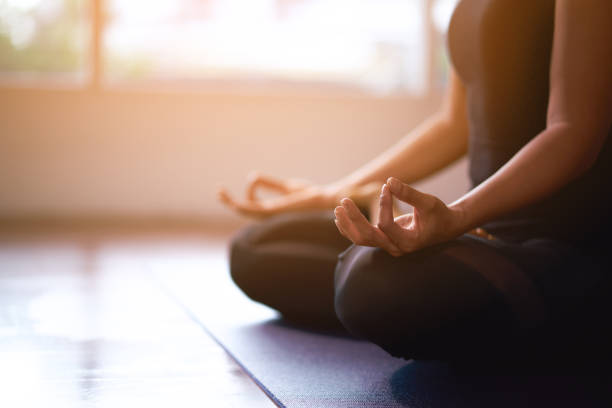In our fast-paced world, the pursuit of tranquility and a good night's sleep has become more important than ever. With the relentless demands of daily life, stress and sleeplessness have become common companions for many.
It's in this context that yoga nidra has gained remarkable popularity as a powerful tool for relaxation and sleep improvement. In this article, we will delve into the growing trend of yoga nidra, exploring its potential to alleviate stress, promote relaxation, and most importantly, enhance the quality of sleep.

What is Yoga Nidra?
Yoga nidra, often referred to as "yogic sleep," is a unique and powerful relaxation technique that allows individuals to experience a state of deep physical and mental relaxation while maintaining full awareness.
Unlike traditional sleep, where you lose consciousness, yoga nidra takes you on a guided journey through various stages of relaxation, ultimately leading to a state that resembles sleep but with heightened consciousness.
During a typical yoga nidra session, practitioners are guided through a series of instructions while lying comfortably in the savasana or corpse pose.
The practitioner focuses on the facilitator's voice, which directs their attention to different parts of the body, breath awareness, and various mental imagery exercises. This guided process enables profound relaxation, inner exploration, and self-awareness.
Yoga Nidra: Brief History and Traditions
The roots of yoga nidra can be traced back to ancient Indian texts and meditation practices. Its history is intertwined with the broader tradition of yoga and meditation, where the goal has always been to attain a higher state of consciousness, self-realization, and inner peace.
Different traditions of yoga nidra have emerged over time, with variations in techniques and practices. These traditions have been influenced by various yogic and spiritual lineages. The concept of yoga nidra is found in tantric tradition, where it is seen as a means to connect with the subconscious and unlock hidden potential.
Swami Satyananda Saraswati's Modern Style
Swami Satyananda Saraswati, founder of the Bihar School of Yoga, introduced yoga nidra to the public in the 1960s through his written works and teachings. His style of yoga nidra is known for its structured approach, making it accessible to a wide audience. Here are some key features of his modern yoga nidra:
-
Systematic Stages: Swami Satyananda's approach divides the practice into stages, each with specific objectives. These stages include body awareness, breath awareness, and guided visualization.
-
Sankalpa: A significant aspect of his method is the inclusion of a sankalpa, a positive affirmation or intention that practitioners set at the beginning of the session. This sankalpa is believed to have a transformative effect on the subconscious mind.
-
Scientific Basis: Swami Satyananda emphasized the scientific benefits of yoga nidra, particularly its ability to induce a state of conscious relaxation, reduce stress, and promote overall well-being.
Swami Satyananda Saraswati's modern style of yoga nidra has gained recognition worldwide and is widely practiced for its therapeutic and rejuvenating effects.
It offers a structured and accessible approach to experiencing deep relaxation and self-awareness, making it a valuable tool for modern life's challenges and stresses.
Understanding the Benefits of Yoga Nidra
Yoga nidra, often referred to as yogic sleep, is a practice renowned for its stress-reduction benefits. By guiding individuals into a state of profound relaxation, it triggers a relaxation response that counteracts the stress response in the body.
This practice's magic lies in its ability to activate the parasympathetic nervous system, often referred to as the body's "rest and digest" mode. As the parasympathetic system takes the reins, heart rate decreases, blood pressure lowers, and a deep sense of calm envelops the practitioner.
Yoga nidra's impact on the parasympathetic nervous system helps restore balance and tranquility in our fast-paced lives, providing a sanctuary of serenity amidst the chaos of the modern world.
Yoga Nidra & Improved Sleep
For those seeking respite from sleep woes, yoga nidra offers a compelling solution. It facilitates a swifter onset of sleep, preparing both mind and body for a peaceful transition into slumber. Beyond mere slumber, yoga nidra enhances the quality of sleep itself.
By alleviating stress and anxiety, it ushers in deeper, more restorative sleep cycles. Insomnia sufferers find solace in yoga nidra's ability to mimic the restorative aspects of sleep while maintaining awareness, helping them transcend the torment of sleeplessness.
Yoga nidra extends beyond its physical and mental benefits, inviting practitioners on a spiritual journey. It becomes a portal to self-discovery, enabling individuals to delve deep into their inner world, unearthing profound insights into their thoughts, emotions, and subconscious patterns.
In the cocoon of its deep relaxation, inner silence emerges—a sanctuary for creativity and self-reflection. This inner stillness nurtures heightened creativity, problem-solving abilities, and a profound connection with one's authentic self.
For many, yoga nidra becomes a wellspring of inspiration, amplifying their capacity for innovation and creative expression, ultimately enriching their lives in unexpected ways.
The Science Behind Yoga Nidra
Yoga nidra bridges ancient wisdom with contemporary science. Scientific studies have validated its profound effects on the brain and body, reaffirming its reputation as a potent well-being tool.
Research using EEG technology reveals that yoga nidra triggers an increase in alpha brainwaves associated with relaxed alertness. This shift enhances cognitive function, mindfulness, and creativity, not only during the practice but also in daily life.
Yoga nidra regulates the autonomic nervous system, favoring the parasympathetic "rest and digest" mode over the sympathetic "fight or flight" response. This shift reduces stress, both physiologically and psychologically, making Yoga Nidra a scientifically supported tool for well-being in our fast-paced world.

How to Practice Yoga Nidra - A Step-by-Step Guide
Yoga nidra offers enticing benefits and welcomes all who want to practice it. If you’re looking to incorporate yoga nidra into your routine, here’s where to start:
Preparation and Creating a Comfortable Environment
-
Find a Quiet Space: Begin by selecting a peaceful and quiet space where you won't be disturbed during your practice.
-
Comfortable Posture: Lie down in the savasana or corpse pose, ensuring your body is straight, and your limbs comfortably apart.
-
Supportive Props: Use a pillow or bolster under your head and a cushion under your knees if needed for added comfort.
-
Cover Yourself: To maintain an ideal body temperature, cover yourself with a light blanket or shawl.
-
Set a Timer: Decide on the duration of your practice, set a timer if desired, and commit to remaining still throughout the session.
The Importance of Relaxation and Staying Awake
-
Intention Setting (Sankalpa): Begin with a clear intention or sankalpa. This is a positive affirmation or resolve that you wish to manifest during or after your practice.
-
Rotation of Consciousness: The practice typically starts with a systematic rotation of consciousness through different body parts. You'll mentally focus on each part, allowing it to relax fully before moving on.
-
Awareness of Breath: Next, shift your attention to your breath. Observe the natural rhythm of your breath without trying to control it. This deepens your relaxation.
-
Feelings and Sensations: Explore your emotions, feelings, and sensations without judgment or attachment. Simply observe them as they arise and pass.
-
Visualization: Engage in guided visualizations that may include serene landscapes, symbols, or affirmations. These help deepen your state of relaxation and facilitate inner exploration.
The Final Steps of Externalization and Waking Up Fully
-
Externalization: Towards the end of the practice, gradually bring your awareness back to your physical body and surroundings. Gently become aware of your surroundings, and when you're ready, move your fingers and toes.
-
Waking Up Fully: As your practice concludes, sit up slowly if you wish or remain lying down for a few more moments. Reflect on your experience, and when you feel ready, return to your usual daily activities, carrying the calm and clarity from your practice with you.
Practicing yoga nidra regularly can cultivate a profound sense of relaxation, self-awareness, and inner peace, making it a valuable addition to your well-being routine.
Incorporating Yoga Nidra into Your Daily Routine
Want to get into the habit of beginning your day with a refreshing yoga nidra session?
Set your alarm a bit earlier to allow time for this practice. As you wake up, find a comfortable spot to lie down and engage in a brief session.
This morning ritual can set a positive tone for your day, helping you stay calm, focused, and emotionally balanced. It's like an inner reset button that readies you to face the day's challenges with a clear mind and a relaxed body.
After Breakfast: Yoga Nidra Throughout the Day
Incorporate short yoga nidra breaks into your daily routine, especially during stressful moments. When you feel overwhelmed or need a mental breather, find a quiet spot, sit comfortably, and engage in a mini yoga nidra session.
Just a few minutes can be remarkably rejuvenating. Use these breaks to recenter yourself, release tension, and regain your composure. It's an effective way to manage stress and maintain your inner balance amidst the demands of daily life.
As the day winds down, consider a longer yoga nidra practice before bedtime. This helps you transition from the busyness of the day to a peaceful night's sleep. Lie down comfortably, and let the practice guide you into a state of deep relaxation.
This bedtime ritual can promote restorative sleep, alleviate insomnia, and ensure you wake up refreshed and ready for a new day. It's a gentle way to release the day's tensions and invite tranquility into your nightly routine.
Deepening Your Yoga Nidra Experience
To deepen your experience with yoga nidra, consider attending workshops or retreats. These immersive experiences provide an opportunity to delve into the practice with guidance from experienced instructors.
Workshops and retreats often offer extended sessions and a supportive environment for self-exploration and growth. They can be transformative experiences that deepen your connection with Yoga Nidra and enhance its benefits in your daily life.

5 Tips to Maximize Your Yoga Nidra Practice
Consistency is Key
Consistency is crucial for reaping the full benefits of yoga nidra. Make it a regular part of your routine, whether it's daily, several times a week, or even once a week. The more you practice, the more you'll become attuned to its nuances, and the deeper your relaxation and self-awareness will become.
Establish a specific time and place for your sessions to build a sense of ritual and commitment. Over time, your mind and body will respond more readily to the practice, enhancing its effectiveness.
Timing Matters
Choose the right time for your yoga nidra practice. Many find that morning sessions help set a positive tone for the day, while others prefer practicing in the evening to unwind and prepare for a restful night's sleep.
Experiment with different times to discover what aligns best with your schedule and personal needs. Timing can significantly influence how deeply you can relax and integrate the benefits into your daily life.
Stay Awake and Aware
One common challenge during yoga nidra is accidentally drifting into sleep. While it's essential to relax, try to maintain a state of wakeful awareness throughout the practice. You want to be in a state of conscious relaxation, not unconscious sleep.
If you find yourself dozing off, gently bring your focus back to the guided instructions or your breath. Staying awake ensures you absorb the practice's full benefits, including increased mindfulness and self-awareness.
Experiment with Different Guided Recordings
Explore a variety of guided yoga nidra recordings led by different instructors. Each instructor brings a unique approach and style to the practice. By experimenting with different recordings, you can find the ones that resonate most with you.
Some may emphasize body scanning, while others focus on emotional healing or spiritual growth. Trying various recordings keeps your practice fresh and allows you to tailor it to your specific goals and preferences.
Emphasize Patience and Self-Compassion
Yoga nidra is a journey, not a destination. Approach your practice with patience and self-compassion. It's natural for your mind to wander or for life's stresses to intrude on your sessions. Instead of getting frustrated, gently guide your focus back to the practice.
Understand that each session may bring different experiences, and that's perfectly normal. Over time, your ability to relax and go deeper within will improve. Be kind to yourself, and let your Yoga Nidra practice evolve at its own pace, nurturing your well-being along the way.
Edobles Sleep Gummies: Your Ticket to Tranquil Slumber
When yoga nidra isn't enough to help you fall asleep, sleep gummies are your gateway to peaceful rest and serenity. These gummies, infused with a blend of potent ingredients, offer a respite from restless nights and the chaos of daily life.
Crafted with care, they promise rejuvenating sleep, even amidst noise and life's challenges. Let’s explore a few of our most popular options.
Deep Dreams Gummies: Deep Dreams Gummies are your path to tranquility. Bursting with Blackberry flavor, they deliver profound sleep, relaxation, and reduced anxiety.
Infused with full spectrum CBD, CBN, melatonin, and L-Theanine, they guide you into peaceful rest. Unlock their potential as they induce deep sleep, soothe with hemp's properties, and reduce anxiety, leaving you refreshed and renewed.
Lucid Dreams Gummies: Lucid Dreams Gummies offer profound sleep, gentle psychoactive bliss, and mental serenity.
Infused with THCP, CBN, full spectrum CBD, and melatonin, they transport you to a realm of relaxation. With melatonin guiding you into deep sleep and a subtle psychoactive buzz enhancing serenity, these Blueberry-flavored squares invite tranquil dreams.

Unlocking Holistic Well-Being with Yoga Nidra
In the fast-paced whirlwind of modern life, we often find ourselves craving moments of peace, serenity, and self-discovery.
Yoga nidra emerges as a powerful and accessible tool, offering profound benefits for our holistic well-being. Its ability to reduce stress, enhance sleep, and cultivate inner calm is nothing short of remarkable.
Embracing yoga nidra is an invitation to embark on a journey of self-discovery, relaxation, and personal growth. It's a reminder that within each of us lies an inner source of peace and tranquility waiting to be tapped into.
With consistency, patience, and an open heart, we can harness the transformative potential of Yoga Nidra to enrich our lives and nurture our inner well-being.
So, whether you're starting your day with a yoga nidra session, taking short breaks for stress relief, or winding down before bedtime, let the practice guide you towards a state of profound relaxation and self-awareness.
In the embrace of yoga nidra, you'll find not only the restful sleep you seek but also the keys to unlocking a deeper connection with yourself and the world around you.







